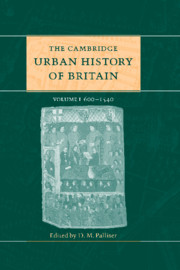Book contents
- Frontmatter
- Part I Introductory
- Part II The early middle ages 600–1300
- Part III The later middle ages 1300–1540
- 12 General survey 1300–1540
- 13 Government, power and authority 1300–1540
- 14 The economy of British towns 1300–1540
- 15 Urban culture and the Church 1300–1540
- 16 The built environment 1300–1540
- 17 London 1300–1540
- 18 The greater towns 1300–1540
- 19 Port towns
- (a) England and Wales 1300–1540
- (b) Scotland 1300–1540
- 20 Small towns 1270–1540
- Part IV Regional surveys
- Part V Conclusion
- Appendix: Ranking lists of English medieval towns
- Select bibliography
- Index
- References
(a) - England and Wales 1300–1540
from 19 - Port towns
Published online by Cambridge University Press: 28 March 2008
- Frontmatter
- Part I Introductory
- Part II The early middle ages 600–1300
- Part III The later middle ages 1300–1540
- 12 General survey 1300–1540
- 13 Government, power and authority 1300–1540
- 14 The economy of British towns 1300–1540
- 15 Urban culture and the Church 1300–1540
- 16 The built environment 1300–1540
- 17 London 1300–1540
- 18 The greater towns 1300–1540
- 19 Port towns
- (a) England and Wales 1300–1540
- (b) Scotland 1300–1540
- 20 Small towns 1270–1540
- Part IV Regional surveys
- Part V Conclusion
- Appendix: Ranking lists of English medieval towns
- Select bibliography
- Index
- References
Summary
As the chief gateways of an island kingdom perched on the periphery of Europe, English and Welsh port towns served a crucial function not only in linking Britain with the continent and neighbouring islands, but also in facilitating inter-island trade and communications. Presiding over this traffic and trade was a wide social and cultural mix of peoples: merchants and mariners, pilgrims and pirates, rich and poor, native English and foreigners who traded by coast and overseas, embarked for distant lands, fished nearby waters, built and owned the country's ships and manned the royal navy. While this concentration of distinctive occupational groups and visitors clearly differentiated seaports from inland settlements, so too did their special relationship with the crown, which relied on the inhabitants of port towns to transport troops and supplies, to collect the hefty revenues associated with royal customs and to police the staple system. Port towns also occupied a significant place in the urban hierarchy; eight of the twenty wealthiest English towns in 1334, seven of the most populous towns in 1377 and half of the twenty wealthiest towns in 1524–5 were port towns. In Wales, six of the ten largest towns around 1300 were seaports.
waterfronts and port administration
This chapter will focus primarily on coastal towns with immediate access to the sea, treating riverine ports only when they were customs headports, such as Exeter and London, or when they could be easily reached by ocean-going ships. Exeter, in fact, was a port town only in an administrative sense since it enjoyed no direct access to the sea, relying instead on its outport four miles south at Topsham, which itself is located at the head of a narrow-channelled estuary, six miles from the open sea.
- Type
- Chapter
- Information
- The Cambridge Urban History of Britain , pp. 467 - 494Publisher: Cambridge University PressPrint publication year: 2000
References
- 4
- Cited by



